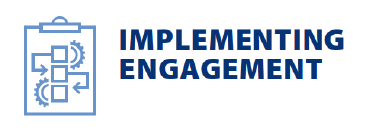 Different levels of engagement may require different approaches to maximizing psychological safety; a climate characterized by:
Different levels of engagement may require different approaches to maximizing psychological safety; a climate characterized by:
- interpersonal trust and mutual respect in which individuals can learn and contribute;
- an environment where individuals feel respected and are not afraid to speak up to share their true thoughts and ideas.
Structuring the engagement
While group psychological safety is something that is cultivated over time, there are opportunities to increase psychological safety within your specific engagement:
- Make psychological safety an explicit priority of the engagement
- Ask individuals what they need to feel psychologically safe and be transparent regarding what you are committing to (and what is possible in the circumstances)
- Set out specific ground rules for the engagement that strongly support respectfulness and fairness
- Set out specific ground rules for the engagement that strongly support respectfulness and fairness
- Ensure structures are in place to allow space for a diversity of voices
- The more diverse the participants and the more complex the issue, the more time will be required for true psychologically safe participation
- A formal facilitator, who does not have a stake in the issue, can help ensure everyone has a chance to contribute
- Replace approaches that favour participation of only a few vocal voices, with approaches that promote wider participation and/or that focus on building trust.
- The more diverse the participants and the more complex the issue, the more time will be required for true psychologically safe participation
- Take stock of how the engagement is unfolding and be prepared to pause and adjust in order to keep your commitment to psychological safety.
Your individual contribution
In addition to structuring your engagement opportunity to maximize psychological safety, your own approach and behaviours are important to promoting psychological safety:
- Be as transparent as possible and acknowledge when you are unable to share information
- Acknowledge areas of ambiguity:
- “You are right, it is not yet clear how we will tackle that situation.”
- “At this time, we remain unsure about….”
- Model curiosity, openness and flexibility at every occasion:
- “I am curious to learn more about that idea. Can you share a little bit more about that?”
- “That’s a perspective that I had not considered.”
- “I wonder how we might be creative and incorporate both of our ideas…”
- Show your own vulnerability and emotion (i.e., be your true self!):
- “I am feeling a little anxious about the proposed timeline….”
- “In thinking this part through, I wish we had …”
- “I’m worried that we are headed….”
- Use your very best active listening skills
- Embrace and transform conflict (see below)
Resources
To support psychological safety, consider co-creating ground rules or shared norms for the engagement. Groups are often well-served by adopting a coherent, ongoing set of agreements about how people will interact with each other during the meetings. This sample template provides an example of 7 ground rules and how they can be incorporated into a visual to share with participants and stakeholders.

